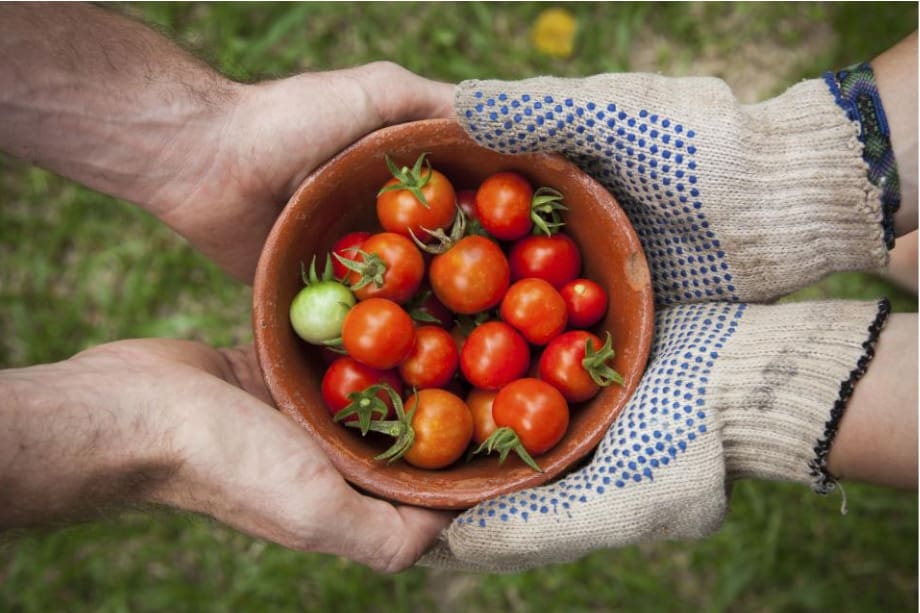Introduction
Tomatoes are among the most popular and rewarding plants to grow in a backyard garden. Not only do they add flavor and freshness to meals, but the satisfaction of nurturing your tomato plants from seed to harvest is unmatched.
Nurturing Tomato Plants for Healthy Growth and Harvesting Tips Welcome back, tomato enthusiasts! This article will delve into the essential aspects of nurturing tomato plants for healthy growth and provide some valuable tips for a bountiful harvest. Tomato Mentor will help you grow vibrant, juicy tomatoes in your garden. Let’s get started!
In another side, Check out this site for additional resources or references on tomato cultivation and further information on common tomato diseases. There you will find a wealth of information to support your journey as a successful tomato gardener.
Getting Started – Basics of Tomato Growing
A. Choosing the Right Tomato Varieties:
To set yourself up for success, choosing the right tomato varieties that suit your preferences and growing conditions is crucial. Consider taste, size, and disease resistance when selecting your tomato varieties. Some popular and highly recommended varieties include heirlooms like Brandywine and Cherokee Purple and hybrids like Early Girl and Celebrity.
B. Preparing the Soil
The foundation of healthy tomato plants lies in the soil. Start by testing your soil pH levels and amending it accordingly. Tomatoes prefer slightly acidic soil, so if your soil is too alkaline, add organic matter or sulfur to lower the pH. Additionally, ensure your soil has proper drainage by amending it with well-rotted compost or organic matter. This will allow the plant’s roots to access necessary nutrients and water without being waterlogged.
C. Planting Tomato Seeds or Seedlings
The next step in growing tomatoes is deciding whether to start from seeds or use seedlings. Starting from seeds gives you a wider selection of varieties, while using seedlings gives you a head start on the growing process.
Cultivating Healthy Tomato Plants
A. Providing the Right Growing Conditions
Tomatoes thrive in well-drained soil under full sun exposure. When transplanting seedlings, bury them deep, up to the first set of leaves, to encourage root development. Proper spacing between plants is crucial to allow air circulation, prevent disease, and promote healthy growth. Provide a sturdy trellis or cage as tomato plants grow tall and heavy.
B. Watering and Fertilizing
Tomatoes need consistent moisture throughout the growing season. Water deeply and evenly. When fertilizing, use a balanced organic fertilizer or compost tea every 2-3 weeks to supply essential nutrients. Avoid over-fertilizing.
C. Pruning and Disease Prevention
Regular pruning helps maintain airflow and reduces the risk of disease. Remove suckers, the small shoots that grow in the leaf axils, to direct the plant’s energy toward fruit production. Additionally, watch for common tomato diseases like blight and blossom-end rot. Promptly remove any infected or diseased leaves to prevent the spread.
Harvesting and Enjoying Your Homegrown Tomatoes
A. Determining Tomato Ripeness
Tomatoes are ripe when they have reached their full, vibrant color and are slightly soft. Avoid picking them too early, as they will not ripen properly off the vine. For indeterminate varieties, which produce tomatoes continuously, harvest them regularly as they ripen to encourage further fruit production.
B. Storing and Preserving Tomatoes
Homegrown tomatoes are best enjoyed fresh, but if you have an abundance, there are various ways to preserve their flavors. Consider canning, making tomato sauces, or freezing them for future use.
Nurturing Tomato Plants for Healthy Growth
A. Watering and Irrigation
When watering tomato plants, finding the right balance is crucial. Watering too little or too much can have adverse effects on their growth. At Tomato Mentor, we recommend watering your tomato plants deeply, ensuring the soil is evenly moist but not soggy. This encourages the development of a robust root system.
Consistent moisture levels are key to avoiding water stress in your tomato plants. Be attentive to dry spells and adjust your watering frequency accordingly. Remember to water early in the morning to allow any excess moisture on the leaves to dry up, preventing potential fungal diseases.
Consider drip irrigation or a soaker hose if you have a garden setup that allows irrigation. These methods ensure efficient water delivery directly to the plant’s root zone while minimizing evaporation.
B. Providing Adequate Sunlight
Tomatoes are sun-loving plants; adequate sunlight is vital for their healthy growth. If your garden has limited sunlight, consider placing your tomato plants in the sunniest spots available.
To maximize sunlight exposure, be mindful of any nearby obstacles that may cast shade on your plants. Pruning surrounding vegetation or using reflective surfaces to redirect sunlight can help your tomato plants receive the optimal amount of sunshine.
Insufficient sunlight can present challenges, especially in shady gardens. Consider growing tomato varieties specifically bred for partial shade conditions in such cases. These varieties are more tolerant of reduced sunlight and will still yield tasty tomatoes.
C. Supporting Tomato Plants
Supporting your tomato plants is essential to prevent sprawling vines, increase airflow, and promote healthy fruit formation. At Tomato Mentor, we highly recommend staking or providing structural support to your tomato plants.
Cages, trellises, and stakes are effective methods for supporting tomato plants. Determine which option suits your garden and tomato variety the best. Cages provide all-around support and are great for sprawling indeterminate varieties. Trellises are ideal for vertical growth, maximizing space in smaller gardens. Stakes can be used for single-stemmed plants that require vertical support.
Harvesting Your Tomatoes
The anticipation of harvesting ripe, juicy tomatoes is one of the most exciting parts of gardening. But how do you know when your tomatoes are ready to be harvested? Tomato Mentor is here to guide you!
Signs of ripe tomatoes include vibrant coloration, a slightly soft texture, and a sweet aroma. Different tomato varieties will have distinct signs of ripeness to look out for, so familiarize yourself with the specific characteristics of the varieties you are growing.
Gently twist your ripe tomatoes off the vine, or use a pair of shears to snip the stem close to the fruit. Avoid pulling or tugging on the fruit, damaging the plant and its future production.
Timing is crucial for harvesting different tomato varieties. Some tomatoes, like cherry tomatoes, are best picked when fully ripe, while others, such as beefsteak tomatoes, benefit from being left on the vine a little longer for optimal flavor development. Check out Tomato Mentor’s website for more detailed information on the best harvesting time for various tomato varieties.
Common Tomato Diseases
A. Introduction to Common Tomato Diseases
Tomatoes are one of home gardens’ most beloved and widely grown vegetables. However, they are also susceptible to diseases that can significantly impact plant health and reduce yield. This blog will explore some of the most common tomato diseases, their symptoms, causes, and, most importantly, how to prevent and manage them effectively.
It is crucial to understand why tomato diseases occur and their impact on plant health. Several factors contribute to developing diseases, including fungal, bacterial, and viral pathogens and environmental conditions. These diseases can cause stunted growth, wilting, leaf spots, and fruit rot.
Implementing proper preventive measures can significantly reduce the risk of disease outbreaks and protect your tomato plants.
B. Identification and Prevention
- Early Blight (Alternaria solani)
- Symptoms: Dark lesions on lower leaves.
- Causes: Fungal pathogen thriving in warm and humid conditions.
- Prevention: Practice crop rotation, ensure proper plant spacing for good air circulation and remove infected plant debris from the garden.
- Late Blight (Phytophthora infestans)
- Symptoms: Dark, water-soaked spots on leaves, stems, and fruit, which eventually develop into large, brown, greasy lesions.
- Causes: Fungal pathogen favored by cool and wet weather conditions.
- Prevention: Avoid overhead watering, provide proper plant spacing for good air circulation, and use resistant tomato varieties.
- Blossom End Rot
- Symptoms: Dark, recessed areas at the blossom end of the fruit.
- Causes: Calcium deficiency in developing fruit due to the plant’s inconsistent watering or inadequate calcium uptake.
- Prevention: Maintain consistent soil moisture, amend soil with organic matter to improve calcium availability, and mulch to conserve moisture.
- Fusarium Wilt (Fusarium oxysporum)
- Symptoms: Yellowing and wilting of lower leaves, followed by eventual death of the entire plant.
- Causes: Soil-borne fungus, often introduced via infected transplants or contaminated soil.
- Prevention: Practice crop rotation, use disease-resistant tomato varieties and ensure proper drainage in the garden.
Crucial preventive measures should be taken to prevent the spread of diseases in your tomato plants. Implement crop rotation by avoiding planting tomatoes in the same spot year after year, as this reduces the build-up of disease-causing pathogens in the soil. Proper plant spacing allows for better air circulation, preventing prolonged leaf wetness and reducing the likelihood of disease development. Maintaining a clean garden by removing diseased plant debris can also help eliminate potential disease sources.
C. Treatment and Management
If your tomato plants have diseases, managing and controlling the issue promptly is important. Home gardeners often prefer natural or organic methods. There are several options to consider:
- Neem Oil: A natural insecticide and fungicide that can help control many tomato diseases. Ensure proper application as per the manufacturer’s instructions.
- Copper-based Sprays: Effective against fungal and bacterial diseases, copper-based sprays can help slow the progression of diseases like early and late blight.
- Cultural Practices: Regularly inspect your plants for any signs of disease and promptly remove infected plant parts.
Contacting your local agricultural extension services is highly recommended for severe cases or when unsure about treatment options. They have experts who can provide professional guidance and advice tailored to your situation.
Conclusion
This blog has covered the most common tomato diseases, their symptoms, causes, and preventive measures. Natural or organic treatments, like neem oil and copper-based sprays, can also help manage diseases effectively. Remember to consult your local agricultural extension services for severe cases or when in doubt.
Now armed with this knowledge, it’s time for you to start confidently growing your tomatoes. Tomatoes are a rewarding and delicious addition to any garden, and by taking proactive steps to prevent, identify, and treat diseases, you can enjoy a bountiful harvest of healthy, disease-free tomatoes.
So, what are you waiting for? Check out this site and read more here to enhance your tomato-growing skills and experience the joy of homegrown tomatoes!
In conclusion, nurturing tomato plants for healthy growth involves proper watering techniques, providing adequate sunlight, and offering structural support. Additionally, mastering the art of harvesting ripe tomatoes at the right time is essential for truly enjoying the fruits of your labor. Check out the Tomato Mentor website for more expert advice and resources on cultivating tomatoes. Happy growing and happy harvesting!
Following this structured guide, you can confidently grow tomatoes like a pro. From choosing the right tomato varieties to providing optimal growing conditions and enjoying the fruits of your labor, the journey of growing tomatoes can be rewarding and delicious. So, roll up your sleeves, get your hands in the soil, and embark on a tomato-growing adventure that will fill your garden with vibrant colors and your plate with the taste of summer.





























